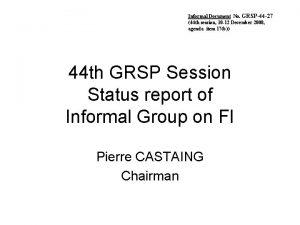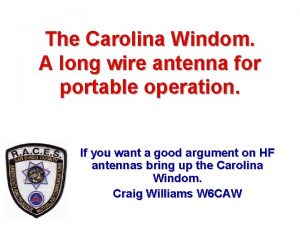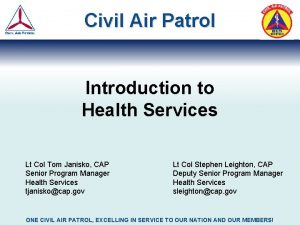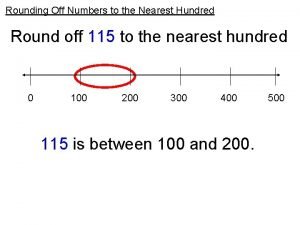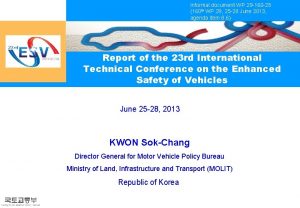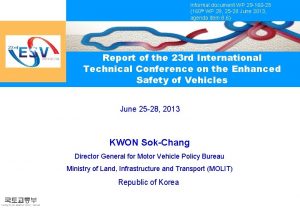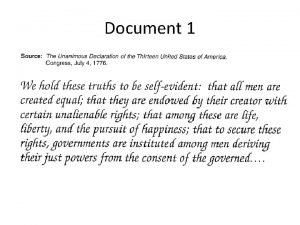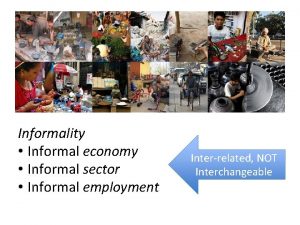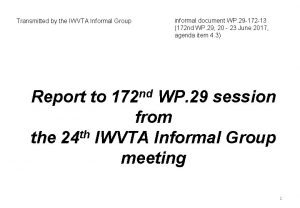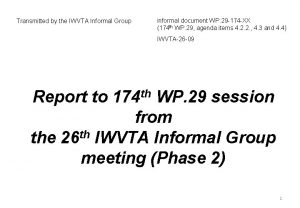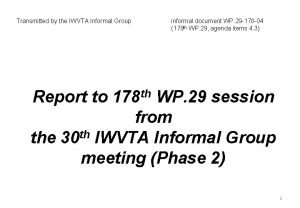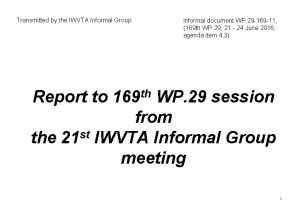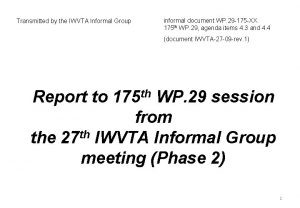Informal document WP 29 160 34 160 th
















- Slides: 16

Informal document WP. 29 -160 -34 (160 th WP. 29, 25 -28 June 2013, agenda item 2. 3) NHTSA’s Driver Distraction Guidelines Christopher J. Bonanti Associate Administrator Rulemaking, NHTSA Human Factors

Visual-Manual Distraction Task-Related Risk and Tasks Affected by Phase 1 Guidelines The most distracting tasks are visual-manual intensive 2

NHTSA’s Distraction Plan § Guidelines are significant portion of Initiative 2 3

Fundamental Principles 1. The driver’s eyes should usually be looking at the road ahead 2. The driver should be able to keep at least one hand on the steering wheel while performing a secondary task (both driving-related and non-driving related) 3. The distraction induced by any secondary task performed while driving should not exceed that associated with a baseline reference task (manual radio tuning) 4. Any task performed by a driver should be interruptible at any time 5. The driver, not the system/device, should control the pace of task interactions 6. Displays should be easy for the driver to see and content presented should be easily discernible 4

Distraction Guidelines Phase 1 § Visual-Manual NHTSA Driver Distraction Guidelines for In-Vehicle Electronic Devices • Refines current Industry Guidelines • Out for public comment in Feb 2012 • Final published on April 2013 5

Phase 1 Approach § Tasks/devices not suitable for performance while driving should be locked out § Two methods for determining if task/device should have lock out: • Per se (i. e. , prohibited by policy or law) for devices/tasks • Do not satisfy test to determine whether tasks can be safely performed while driving § Devices/tasks with per se lock out or that do not satisfy test should not be accessible if engine turned on unless vehicle is in “Park” 6

Phase 1 Approach § Acceptance tests • Testing procedures with human subjects • Limits for time spent looking away from the roadway • Limits to both total eyes-off-road time and individual glance duration • Manual radio tuning as reference task § Per se lock outs • Particular functions or features that should be locked out regardless 7

Acceptance Tests and Thresholds § NHTSA’s preferred test protocols: • Driving simulator testing and eye glance measurement • Similar to the Alliance 2. 1 A testing protocols in the Alliance Guidelines • Occlusion testing • Based on the ISO 16673: 207 testing protocol • 1. 5 seconds shutter open/1. 5 seconds § NHTSA’s acceptance threshold: • 2/12 8

Per Se Lock Outs § Particular functions or features that should be locked out regardless • Device functions and tasks not intended to be used by a driver while driving. (e. g. , setting the clock) • Manual Text Entry. Locks out texting, chatting, and internet browsing • Displaying Video • Displaying Images • Automatically Scrolling Text • Displaying Text to Be Read. Locks out the display of books, web page content, social media content, etc. 9

Changes from the Proposed Guidelines § Clarifies that the Guidelines apply both to some drivingrelated secondary tasks and to all non-driving-related secondary tasks performed using an original equipment electronic system or device § The Guidelines explicitly do not apply to ambulance, firefighting, law enforcement, military, and other emergency vehicles § The TSOT criterion has been changed from 9 seconds to 12 seconds so that it is consistent with the 12 -second TEORT criterion 10

Changes from the Proposed Guidelines § Numerous changes have been made to the recommended per se lock outs • The 6 -button press limit for manual text entry has been replaced by a recommendation against any amount of manual text entry by the driver for the purpose of text-based messaging, other communication, or internet browsing • The 30 -character limit for displaying text to be read has been replaced by a recommendation against displaying any amount of text for reading from books, periodical publications, web page content, social media content, text-based advertising and marketing, or textbased messages. The display of limited amounts of other types of text as part of a task are acceptable as long as the task meets the “ 2/12” acceptance criteria 11

Changes from the Proposed Guidelines § Numerous changes have been made to the recommended per se lock outs • The Guidelines clarify that the display of dynamic and static maps and/or location information in a two-dimensional format, with or without perspective, for the purpose of providing navigational information or driving directions when requested by the driver is acceptable • However, the display of informational detail not critical to navigation, such as photorealistic images, satellite images, or three-dimensional images is not recommended • The per se lock out of displaying graphical and photographic images has been revised to exclude images displayed for the purpose of aiding a driver to efficiently perform a task if the image automatically extinguishes from the display upon completion of the task • The per se lock out of displaying video has been revised to exclude the display of visual images of the area directly behind a vehicle intended to aid a driver in performing a maneuver in which the vehicle’s transmission is in reverse gear (including hitching a trailer) is acceptable, subject to certain conditions 12

Additional Information § Driver Distraction Guidelines Docket: • Website: www. regulations. gov • Docket Number: NHTSA-2010 -0053 § FYI: National Survey on Distracted Driving Attitudes and Behaviors • www. nhtsa. gov/staticfiles/nti/pdf/811729. p df 13

Distraction Guidelines Phase 2 § Visual-Manual Interfaces for Portable Aftermarket Devices • No current Industry guidelines • Currently under development 14

Distraction Guidelines Phase 3 § Auditory-vocal Interfaces for In-Vehicle Electronic Devices and Portable Aftermarket Devices • No published Industry guidelines • Research currently underway 15

Questions? Human Factors
 Document.write(document.cookie)
Document.write(document.cookie) Informal document
Informal document Culto casual
Culto casual 1/4 to decimals
1/4 to decimals 37521 to the nearest 10
37521 to the nearest 10 Rd n° 160-2015/digesa/sa
Rd n° 160-2015/digesa/sa Carolina windom 80
Carolina windom 80 12vac35-105-620
12vac35-105-620 Edu mölndal
Edu mölndal 100+120+140+160+180
100+120+140+160+180 Capr 160-1
Capr 160-1 6280/160
6280/160 Ecomagination
Ecomagination Bimetallic stemmed thermometer definition
Bimetallic stemmed thermometer definition Parafrasi il canto delle sirene
Parafrasi il canto delle sirene 160/60
160/60 650 to the nearest hundred
650 to the nearest hundred

